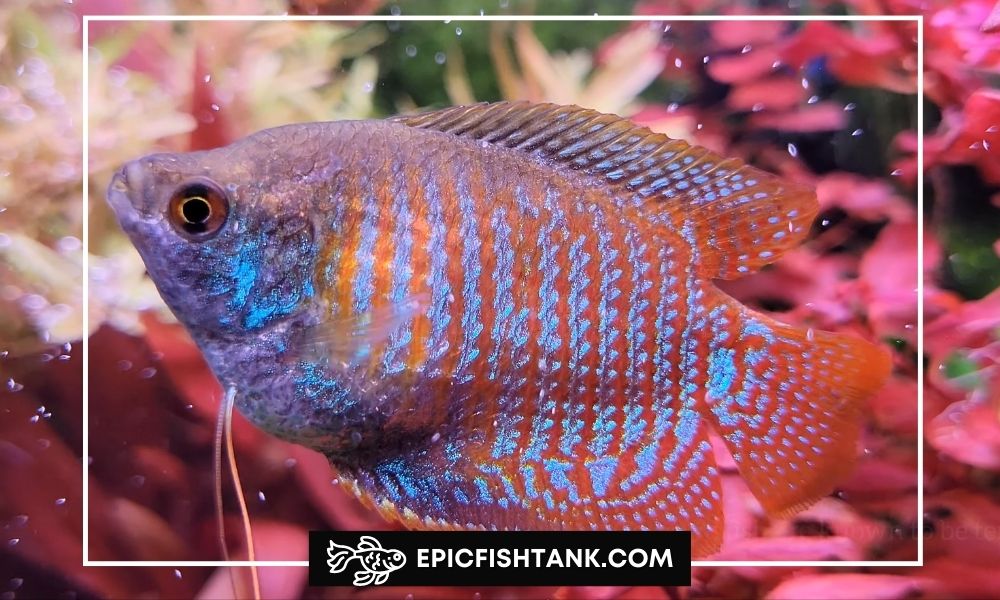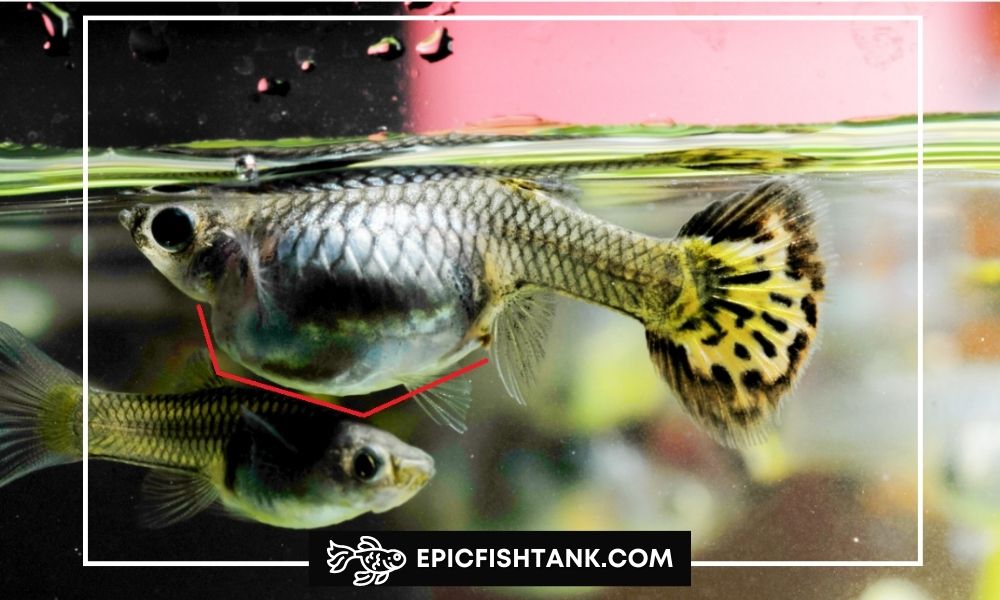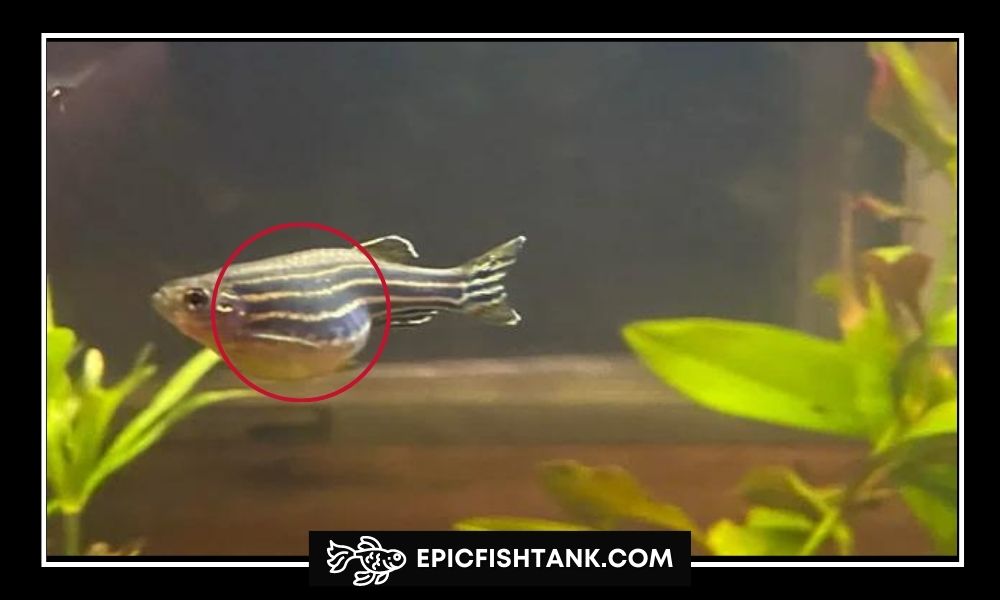Dwarf Gourami Breeding: A Comprehensive Guide

Dwarf Gourami Breeding is an exciting and rewarding hobby for fish enthusiasts. With a little research and preparation, you can successfully breed these beautiful and colorful fish in your own home aquarium. Read on to learn more about the process and what you need to know to get started.
Male VS Female Gouramis: How to Identify the Gender
There are several distinguishing features that can help you identify the gender of Dwarf Gouramis:
- Coloration: Male Dwarf Gouramis typically have more vivid and intense colors compared to females, which usually display duller and more subdued hues. Males may also exhibit more intricate patterns, whereas females often have simpler markings.
- Dorsal Fin: The dorsal fin of male Dwarf Gouramis is pointed and elongated, while females have a rounded, shorter dorsal fin. This difference is particularly noticeable when the fish are fully mature.
- Body Shape: Males generally have a slimmer body shape compared to females. Female Dwarf Gouramis tend to have a rounder body, particularly when they are carrying eggs.
- Behavior: Male Dwarf Gouramis can be more territorial and aggressive, particularly during the breeding season when they are defending their bubble nests. Females are typically less aggressive and more submissive in their interactions with other fish.
Summary of male vs female gourami differences:
| Feature | Male | Female |
|---|---|---|
| Coloration | More vibrant and intense | Duller and more subdued |
| Dorsal Fin | Pointed and elongated | Rounded and shorter |
| Body Shape | Generally slimmer | Rounder, especially when carrying eggs |
| Behavior | More territorial and aggressive | Less aggressi |
EpicFishTank Note:
Dwarf Gouramis are egg-layers, not livebearers. The reproductive process for Dwarf Gouramis involves males building bubble nests, courting females, and fertilizing the eggs externally.
Once the eggs are fertilized, the male places them in the bubble nest, where they will develop until hatching. This is in contrast to livebearers, such as guppies and mollies, which give birth to fully-formed, free-swimming fry after internal fertilization and gestation.
How to Breed Dwarf Gouramis
In this section, we’ll guide you through the steps to successfully breed Dwarf Gouramis, with a focus on triggering spawning, providing the right environment, and caring for the offspring.
💡Preparing the Breeding Tank
Creating a suitable environment is crucial to encourage Dwarf Gouramis to breed. Here are some steps to stimulate breeding conditions:
Set up a separate breeding tank: To ensure a controlled environment and to prevent any disturbances from other tank mates, it is advisable to set up a separate breeding tank. A 10 to 20-gallon tank should suffice.
Lower the water level: Reduce the water level in the breeding tank to six to eight inches. This shallow environment will help the male Dwarf Gourami create a stable bubble nest for the eggs.
Adjust the water temperature: Increase the water temperature to 77 degrees Fahrenheit (25 degrees Celsius) to trigger spawning. The ideal temperature range for Dwarf Gouramis is usually between 72 and 82 degrees Fahrenheit (22-28 degrees Celsius), but the higher end of this range encourages breeding behavior.
Add vegetation: Provide ample plant cover in the breeding tank to facilitate nest building. Floating plants like Water Sprite or Hornwort are ideal, as they provide the necessary materials for the male to construct a bubble nest. Additionally, plants provide hiding spots for the female and, eventually, the fry.
Ensure proper filtration and aeration: Use a sponge filter with gentle aeration in the breeding tank to maintain water quality without disrupting the bubble nest.
💡Introducing the Breeding Pair:
Breeding Dwarf Gourami is a simple and enjoyable process, provided you have the time and a sexually mature pair of fish. Here are the steps to follow:
Step 1: Choosing the Right Pair
Choose a pair of Dwarf Gourami that are sexually mature. Typically, they will be around 9 months old before they are ready to breed. Look for a male and female with vibrant colors and healthy appearances.
Step 2: Tank Set-up
Set up a 20-gallon tank for breeding Dwarf Gourami. Add a heater to maintain a temperature of around 77-82°F (25-28°C), and install a gentle filter that doesn’t create too much water movement. Create plenty of hiding places in the tank using live plants, rocks, or artificial decorations. You should also add floating plants or objects at the surface of the water to help support the bubble nest.
Step 3: Introducing the Fish
Add the female Dwarf Gourami to the breeding tank first. Give her time to explore and find hiding places before introducing the male Dwarf Gourami a few hours later. This allows the female to establish her territory and feel more comfortable. If the male becomes aggressive towards the female, remove her from the tank and try again later.
Step 4: Preparing for Breeding
Once the male and female have been introduced to the breeding tank, you can start preparing for breeding. Feed them a high-quality diet of live or frozen foods such as brine shrimp or bloodworms to help condition them for spawning. Avoid feeding them pellets, as these can cause digestive problems.
Step 5: Observing the Breeding Behavior
Observe the behavior of the fish closely. You’ll know that they are ready to breed when you see the male and female Dwarf Gourami “dancing” around each other. The male will begin to build a bubble nest at the surface of the water using saliva and plant materials. This is where the eggs will be laid.
Step 6: Spawning
When the female Dwarf Gourami is ready to lay her eggs, she will signal this to the male by swimming near the bubble nest. The male will wrap himself around the female to embrace her and release sperm. This fertilizes the eggs, which the female will release at the same time. The male will collect the eggs with his mouth and place them into the bubble nest.
Step 7: Removing the Female
As soon as the spawning is complete, remove the female Dwarf Gourami from the breeding tank. She will try to eat the eggs, and the male may become aggressive towards her. It’s important to remove her as soon as possible to avoid this.
Step 8: Caring for the Eggs
The male Dwarf Gourami will take care of the eggs by guarding the bubble nest and adding more bubbles as needed. Make sure the water quality remains stable by performing partial water changes as needed. Keep the temperature and pH levels consistent.
Step 9: Raising the Fry
Once the eggs hatch, the fry will be very small and require special care. Feed them small amounts of freshly hatched brine shrimp or liquid fry food several times a day. Gradually increase the amount of food as the fry grow. Keep the water clean by performing regular partial water changes. Be careful not to overfeed, as this can cause poor water quality.
Step 10: Separating the Fry
As the fry grow, they will become more active and need more space. Once they are around 1-2 months old, you can separate them into a different tank. This will prevent larger fish in the main tank from eating them.
Spawning and Fry Care
Observe spawning behavior: The male will start building the bubble nest using plant materials and saliva, binding the pieces together with bubbles. Once the nest is complete, the male will court the female, and if she is receptive, they will spawn. The male will wrap his body around the female, and she will release her eggs, which he will then fertilize.
Care for the eggs: After spawning, the male will place the fertilized eggs into the bubble nest. At this stage, it is crucial to remove the female from the breeding tank, as the male may become aggressive while protecting the nest. The eggs will hatch in approximately 24-36 hours.
Tend to the fry: The fry will become free-swimming after 3-4 days. Once they are swimming, provide them with nutritious foods like infusoria or freshly hatched brine shrimp. As they grow, you can gradually introduce them to finely crushed flake food.
Transition to the main tank: After 4-6 weeks, the fry should be large enough to be introduced to the main tank or moved to a separate grow-out tank. Ensure that they are not placed with aggressive tank mates or fish large enough to see them as prey. Gradually acclimatize them to the new tank environment by slowly mixing water from the main tank into the grow-out tank over the course of an hour.
Monitor the fry’s development: Keep a close eye on the growth and health of the young Dwarf Gouramis. Maintain optimal water conditions by regularly monitoring water parameters and conducting water changes as necessary. As they grow, the fry can be fed a varied diet of crushed flake food, micro worms, and baby brine shrimp to ensure proper nutrition.
Sex the young Dwarf Gouramis: As the fry mature, you will be able to identify their sex based on their coloration and fin shapes. Males will exhibit more vibrant colors and a pointed dorsal fin, while females will have a rounder dorsal fin and duller coloration. At this stage, it may be necessary to separate males and females or provide a larger tank to prevent aggression between males.
FAQs
How many eggs do dwarf gouramis lay?
Dwarf gouramis are prolific breeders and can lay a large number of eggs in a single breeding cycle. The exact number of eggs laid can vary depending on the size and health of the female, as well as the conditions in the breeding tank.
However, on average, a female dwarf gourami can lay up to 600 eggs in one breeding cycle.
Final Words
Breeding dwarf gouramis can be a rewarding and fascinating experience for fish enthusiasts. With their beautiful colors and interesting behaviors, these fish make great additions to any aquarium. However, it’s important to do your research and prepare properly before attempting to breed dwarf gouramis.
Remember to set up a separate breeding tank with plenty of hiding places and plants for the female to lay her eggs on, and to maintain good water quality and temperature for optimal breeding conditions. While dwarf gouramis do not provide parental care for their eggs or fry, with proper care and attention, you can successfully raise the fry to maturity.
If you have any concerns or questions about breeding dwarf gouramis, don’t hesitate to consult a veterinarian who specializes in fish health. They can provide valuable advice and guidance to ensure that your fish remain healthy and happy throughout the breeding process. Good luck and happy breeding!
References
- Fishlore.com | How do I know when dwarf gourami are ready to breed?
Time for a coffee break! With your support, We can keep working hard and creating fantastic content. #let's make it happen!
Author
Reza is a digital marketer and an avid freshwater aquarist. He's been keeping fish tanks for more than 10 years and has always been fascinated by the delicate balance of life in water.
Reza loves to share his knowledge about both digital marketing and fishkeeping with others, and he is always happy to help new aquarists get started in this rewarding hobby.
Wibisono is a freshwater fish breeder who raises and breeds different species of ornamental fish like betta, guppy, flowerhorn, and goldfish. He has been in the business since 2018 and exports his fish to different countries. He is committed to providing high-quality and healthy fish to his customers.




Leave a Reply